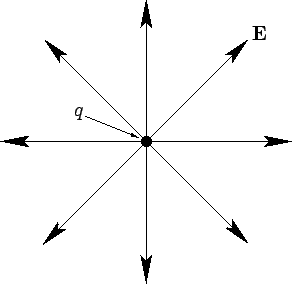 |
The direction of the electric field is everywhere tangent to the field-lines, in the sense of the arrows on the lines. The magnitude of the field is proportional to the number of field-lines per unit area passing through a small surface normal to the lines.Thus, field-lines determine the magnitude, as well as the direction, of the electric field. In particular, the field is strong at points where the field-lines are closely spaced, and weak at points where they are far apart.
The electric field-lines associated with a positive point charge are a set of unbroken, evenly spaced (in solid angle) straight-lines which radiate from the charge--see Fig. 9. Thus, the tangent to the field-lines is always directed radially away from the charge, giving the correct direction for the electric field. The number of electric field-lines per unit area normal to the lines falls off like
By analogy, the electric field-lines associated with a negative point charge are a set of unbroken, evenly spaced (in solid angle) straight lines which converge on the charge.
As a general rule, electric field-lines generated by fixed charges begin on positive charges, end on negative charges, and are unbroken and never cross in the vacuum regions between charges.